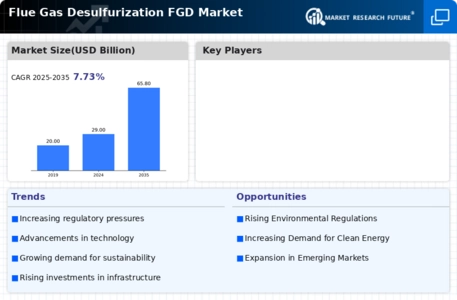Economic Growth and Industrial Expansion
The Flue Gas Desulfurization FGD Market is poised for growth due to economic expansion and industrial development in emerging markets. As countries industrialize, the demand for energy increases, leading to a rise in coal-fired power generation. This trend necessitates the implementation of FGD systems to mitigate sulfur emissions and comply with environmental regulations. For instance, regions with burgeoning manufacturing sectors are likely to see a heightened need for FGD technologies to address pollution concerns. The market is projected to benefit from this industrial growth, with an expected increase in FGD system installations. Analysts suggest that the market could reach a valuation of USD 28 billion by 2026, driven by the intersection of economic development and environmental responsibility.
Technological Advancements in FGD Systems
The Flue Gas Desulfurization FGD Market is experiencing a surge in technological advancements that enhance the efficiency and effectiveness of desulfurization processes. Innovations such as advanced sorbent materials and improved reactor designs are being developed to optimize the removal of sulfur dioxide from flue gases. For instance, the integration of artificial intelligence and machine learning in monitoring systems allows for real-time adjustments, leading to reduced operational costs and improved performance. As a result, the market is projected to grow at a compound annual growth rate of approximately 5.2% over the next five years, driven by these technological improvements. Furthermore, the adoption of hybrid systems that combine multiple desulfurization technologies is likely to gain traction, providing operators with flexible solutions to meet varying regulatory requirements.
Regulatory Compliance and Environmental Standards
The Flue Gas Desulfurization FGD Market is significantly influenced by stringent regulatory compliance and environmental standards aimed at reducing sulfur emissions. Governments worldwide are implementing more rigorous regulations to combat air pollution, which necessitates the installation of FGD systems in coal-fired power plants and industrial facilities. For example, the introduction of the Clean Air Act in various regions has mandated the reduction of sulfur dioxide emissions, compelling industries to invest in FGD technologies. This regulatory pressure is expected to drive the market, as companies seek to avoid penalties and enhance their environmental credentials. The market is anticipated to witness a steady increase in demand for FGD systems, with an estimated market value reaching USD 25 billion by 2027, reflecting the growing emphasis on compliance and sustainability.
Sustainability Initiatives and Corporate Responsibility
The Flue Gas Desulfurization FGD Market is increasingly shaped by sustainability initiatives and corporate responsibility commitments from various sectors. Companies are recognizing the importance of reducing their carbon footprint and enhancing their environmental stewardship. As a result, there is a growing trend towards the adoption of FGD systems as part of broader sustainability strategies. Industries such as power generation and manufacturing are investing in cleaner technologies to align with global sustainability goals. This shift is likely to bolster the FGD market, as organizations seek to implement effective solutions for sulfur dioxide emissions. Furthermore, the increasing consumer demand for environmentally friendly practices is pushing companies to prioritize investments in FGD technologies, potentially leading to a market expansion valued at over USD 30 billion by 2028.
Investment in Renewable Energy and Transition Strategies
The Flue Gas Desulfurization FGD Market is also influenced by the ongoing investment in renewable energy and the transition strategies adopted by various countries. As the global energy landscape shifts towards cleaner sources, there remains a significant reliance on fossil fuels, particularly coal, in many regions. This duality creates a demand for FGD systems to reduce emissions while transitioning to renewable energy sources. Governments and private sectors are investing in FGD technologies as a bridge solution, ensuring compliance with environmental standards during this transition. The market is likely to see a sustained demand for FGD systems, with projections indicating a potential market size of USD 27 billion by 2029, as industries navigate the complexities of energy transition while maintaining operational efficiency.

















Leave a Comment